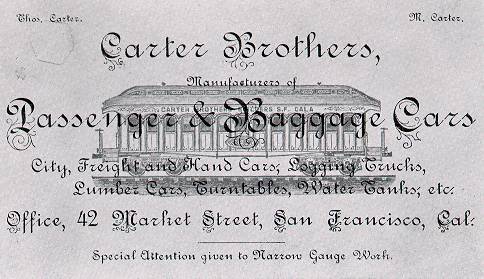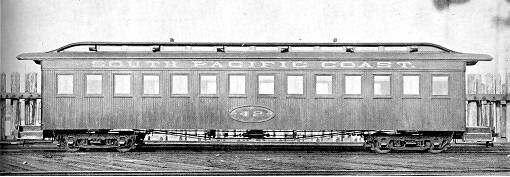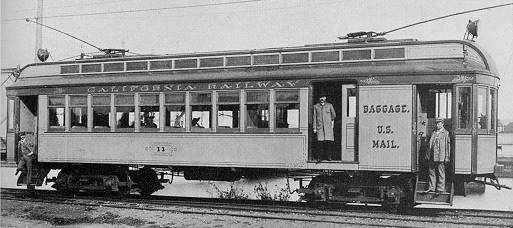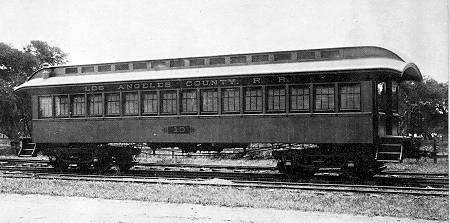Carter Brothers, Builders
Thomas Carter was a “young, enterprising carpenter and journeyman machinist” {34} (another source says an experienced carriage builder, which might sum up the other two) when he came to California in 1862 from the East. He went to work for the contracting firm of L.L. Robinson—then building cars for the Sacramento Valley Railway, California’s first—and when the job was finished, became foreman in its shops at Folsum. Martin followed his older brother in 1863, and went to work in the family trade of carriage building. The two may have briefly been in the railway car building business together before Thomas went to Oregon to work at building the line from Portland, OR to Oregon City. Martin went into horse car manufacture, outfitting the Market Street line, as well as general carpentry, where he was involved in the construction of fine staircases, including the original grand staircase in the State Capitol building in Sacramento. In 1872, the Carters opened a shop in Sausalito and began building rolling stock and bridges for the North Pacific Coast Railroad. Their business listing in the San Francisco city directory was “Railroad Contracting.” {34}
In 1873, they opened another shop in Monterey and began building cars for the Salinas Valley Railroad. Costs had to be shaved to the bone, and the Carters did this by literally building cars “on-the-spot,” largely from native materials. In two years they built 44 freight cars and two lightweight passenger cars. Meanwhile, they built the line’s bridges, including a 300 foot long high trestle over the Salinas River. By 1875, the Sausalito shops were the hub of three Carter jobs: the North Pacific Coast, the Monterey & Salinas Valley, and a new project for the Santa Clara Valley Railroad Company at Dumbarton Point. The latter went bust, but was soon replaced by the budding South Pacific Coast Railroad Company. One writer describes Carter Brothers as
The South Pacific Coast Railroad gave Carter Brothers contracts for several hundred freight cars, scores of first class passenger cars, and subgrading and bridgework for the first 20 miles of line. And Thomas Carter was appointed road superintendent of construction. By July of 1876 he had up-and-running at the site of Newark a machine shop, blacksmith shop, roundhouse and parts sheds for the railroad, as well as three buildings (erection hall, paint shop and tool shop) for their own operation. They were building the new cars by August.
By 1885, Carter Brothers had produced more than 600 cars for the SPCRR. They specialized in narrow gauge equipment, but also built horse cars, cable cars, a few electrics, turntables, water tanks and some standard gauge equipment, and at least one interurban. One authority estimates they built about 5,000 cars in a little over 28 years, and has composed a list of them (see bibliography, below). Martin was the car builder, supervising production and managing the Newark shops, while Thomas was the businessman, keeping the books, making sales, and—after their operation had settled down at the Newark plant—establishing permanent offices in San Francisco.
Carter also exported equipment as far away as Brazil and Alaska. Cars would be built and assembled in Newark, painted, and then carefully disassembled, shipped to the destination, and then reassembled by workers sent along with the “kits.” Destinations included Mexico, Guatamala, Hawaii, San Salvador, and Rio de Janeiro. Legend has it that these cars were so well built and well packed they didn't need even touch-up paint. Carter built most of the cable cars for San Francisco’s Market Street Railroad to provide service to the 1894 Midwinter Exposition in Golden Gate Park, and power trucks to electrify East Bay horsecars. Many railroads ordered Carter Brothers parts, not just for repairs, but for their own car construction. Especially well liked were the swing-motion trucks engineered by Thomas Carter, which were economical to build and were easily repaired.
Shortly after the South Pacific Coast was leased to the Southern Pacific in 1887, Thomas Carter rented the Carter Brothers' Newark shops to them. Thereafter, car building was limited, but did continue. In 1888, they completed an order for 25 extra-long—32 foot—box cars and 75 flat cars for the SPC, and were working on several new coaches. One of the last orders was for a series of electric trailers for the California Railway in 1896. Carter Brothers reportedly quit building cars in 1897. But an inventory taken 21 August 1899 shows the Carter Brothers operation still had assets of $4,417.56. {30} Martin Carter retired and shut down the company in 1902 after an unsuccessful attempt to hire someone to continue as manager of the business, but apparently a trickle of parts was still being supplied as late as 1906. For More Information —MacGregor, Bruce A. The Birth of California Narrow Gauge; A Regional Study of the Technology of Thomas and Martin Carter. (Palo Alto, CA: Stanford University Press, 2003).
MacGregor, Bruce A. Narrow Gauge Portrait: South Pacific Coast. (Felton, CA: Glenwood Publishers, 1975).
MacGregor, Bruce A. South Pacific Coast. (Berkeley, CA: Howell-North Books, 1968).
Stanley, Dr. Leo L. “Carter Bros. Builders.” The Western Railroader, Volume 37, Issue 410, July 1974, pages 3-8. Online —
|



